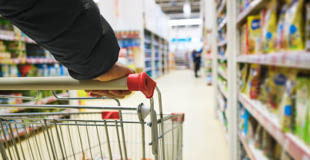Key Findings
- Trader Joe’s has maintained a public beyond restricted substance list (BRSL) and beyond restricted material list (BRML) for its packaging since December 2018, asking vendors to avoid per- and polyfluoroalkyl substances (PFAS); bisphenol A (BPA) & bisphenol S (BPS); nonylphenol ethoxylates (NPEs); polystyrene (PS); styrene; and phthalates. In late 2018 and in 2019, the company reported some progress on phasing out certain uses of Styrofoam in its packaging, although it has not confirmed the alternatives in use are safer.
- In 2020, the company highlighted on its website that it was newly restricting a chemical of high concern from a major category of its own-brand products and announced a consumer-facing disclosure policy that “for health and beauty products, household products…whatever is in there is listed on the label.” The company’s efforts still do not amount to a safer chemicals policy. In May of 2018, the company disclosed on its website that it would be rolling out non-phenol receipt paper in the next few months but has not reported on progress in this area since then and has removed this information from its website.
Recommendations for Trader Joe’s
- Trader Joe’s can make progress by developing a public written safer chemicals policy that pulls together and expands on its existing beyond restricted substance lists (BRSL) and beyond restricted material list (BRML) and sets public quantifiable goals with clear timelines for reducing and eliminating chemicals of high concern (CHCs) and plastics of environmental health concern (PEHCs). The company should also set and disclose strong accountability measures to enforce the policy.
- Specifically, the company should expand its packaging BRSL to all bisphenols and expand its restriction on phthalates to also focus on food-contact materials in its supply chain. Trader Joe’s should swiftly eliminate all polystyrene (including Styrofoam) from all of its packaging and any related materials, and act to phase out other PEHCs, such as polyvinyl chloride. The company should also adopt and disclose a comprehensive BRSL for its household cleaning and health and beauty products.
- Trader Joe’s should fully, publicly disclose the alternatives used to replace CHCs and PEHCs after eliminating them. The company should become a signatory to the Chemical Footprint Project and pilot it with key private label suppliers.
Grade History
How does Trader Joe's compare to its competitors?
Analysis of Trader Joe’s
Oversight: Established management responsibilities and incentives
Disclosure: Requires suppliers to report use of chemicals in products to retailer
Action: Reduced or eliminated chemicals of high concern (CHCs) or plastics of environmental health concern (PEHCs) within the last three years
Safer Alternatives: Evaluates safer alternatives, avoids regrettable substitutes
Transparency: Demonstrates a commitment to transparency and public disclosure
Third-party Standards: Promotes credible third-party standards for safer products
Extra Credit:
Joint Announcement: Public commitment demonstrated through joint announcement
Continuous Improvement: Shows continuous improvement by steadily expanding safer chemicals policy
Collaboration: Actively participates in collaborative process to promote safer chemicals
Impact Investment: Investing financial resources into independent research into safer alternatives and/or green chemistry solutions


